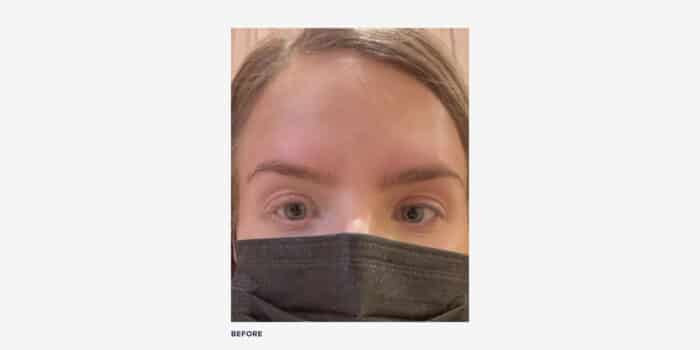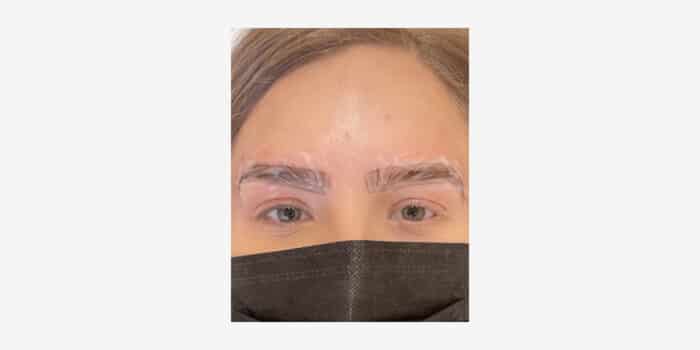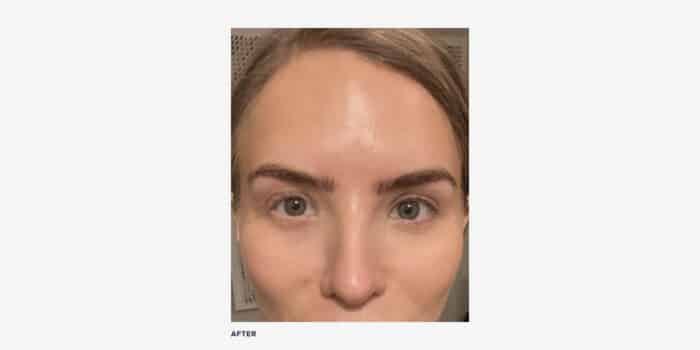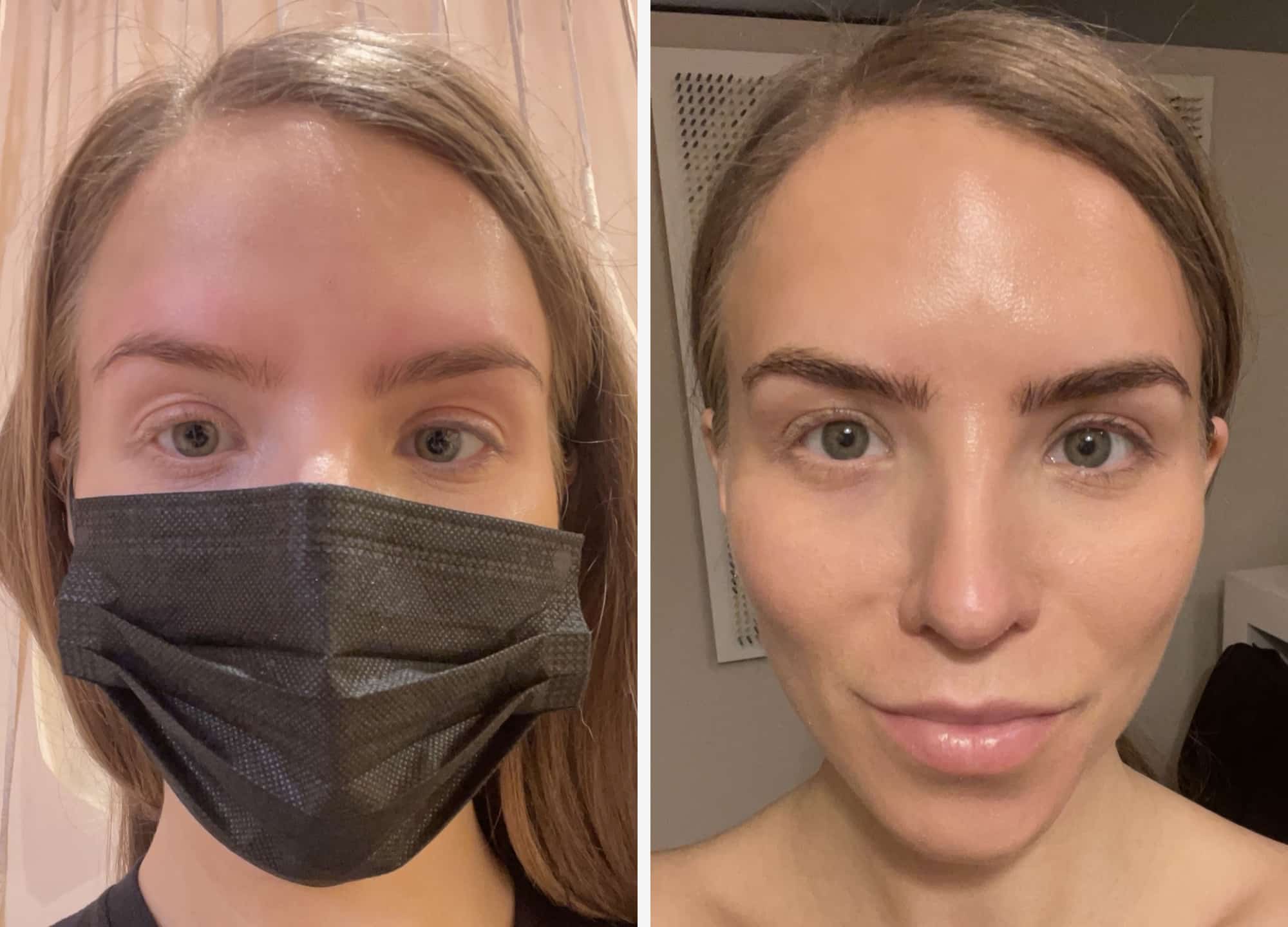The Backstreet Boys were right about at least one thing: what makes you different makes you beautiful. In fact, this philosophy has informed most of my life and shaped the way I see myself. Instead of fretting over the prominent birthmark on my arm, I’ve embraced it, showing everyone who comes across it how it resembles Dumbo the elephant; and rather than feel shameful of my deep and dorky love of punctuation, I’ve attached “Team Oxford Comma” stickers to every laptop I’ve ever owned. But there’s one feature of mine that I’ve always had a difficult time accepting: my chimeric eyebrows and eyelashes.
From the day I was born, my left eyebrow and eyelashes have been blonde; my right eyebrow and eyelashes, brunette. It’s unclear whether this asymmetry is a result of something going seriously awry in the womb or if it’s just a product of my vitiligo, but for as long as I can remember, I’ve looked like a different person on each side of my face. When I started wearing mascara in my teenage years, it helped mitigate the contrast between my eyelashes, but even as my blonde eyebrow started darkening slightly with age, it still bothered me.

I started getting my eyebrows tinted every few months, to even out the color, and it worked well, but the dye tended to fade within a matter of weeks, leaving me to touch it up with eyebrow gel and pencil. When the pandemic first hit, I basically stopped wearing makeup altogether, making the color difference even more pronounced, but with a brow-tinting appointment rendered impossible, I had to take matters into my own hands and started dyeing my brows at home.
Even as I’ve continued my at-home tinting over the past year and a half though, I’ve longed for a more permanent solution. As a beauty writer, I have the privilege of learning about some of the most cutting-edge treatments and technologies, often before they’re even available, but nothing seemed to offer what I was looking for. It really wasn’t until I took a deeper dive into microblading, a treatment I’d heard of years earlier but had dismissed as a fix for thin or patchy eyebrows rather than color, that I felt there could be an answer after all.
I learned that microblading, a form of semipermanent tattooing, is designed to mimic the look of natural brow hairs. So although it’s especially useful for shaping eyebrows and enhancing existing hair, I was told I could also benefit from the treatment. I booked my appointment immediately.
My microblading appointment
I made my way to Shen Beauty in Brooklyn, New York, on an early December afternoon, eager to start the process. I was greeted by brow specialist Joshua Beeler and taken to a treatment room. Beeler removed the makeup on my face and plucked stray brow hairs with a tweezer; then he outlined my brows with an eyeliner pencil, to create a border to stay within when he tattooed. Finally, he applied a hefty amount of numbing cream to both of my brows, going slightly above and below, and led me to the bed before leaving the room to grab his tools.

When he returned 10 minutes later, I was amazed to see him in full scrubs—the man was not messing around. He brought over a bright light and all of his equipment, then wiped off the numbing cream, which at that point had removed basically all feeling from my brow area. Before he started, he warned me that many people find the sensation quite unpleasant and that I would likely still feel the tiny pricks. I explained that I have a very high pain tolerance—but since I’ve never gotten any traditional tattoos, I was totally unsure of what to expect.
What microblading pain is like
As Beeler started on the outer side of my left brow (the blonde one), I truly couldn’t feel a thing, but as he moved inward, and especially on the lower part of my brow, where the skin is thinner, it felt like tiny little needles pricking me continuously. It was unlike any sensation I’d ever felt; the only thing I could compare it to is microneedling. I could absolutely see how microblading would be uncomfortable for someone more sensitive to pain.
When I asked Beeler, who has a number of tattoos himself, how this compared to traditional tattooing, he explained that traditional tattoos are always done with a machine. “This can be done on the brows as well, but I prefer to do a manual method, as it produces a more natural effect,” he said. The way that microblading works, however, isn’t all that different. “The actual process of microblading is to insert pigment into the skin that mimics the appearance of brow hairs,” Beeler noted. The only real disparity is that unlike tattooing, microblading happens more on the surface of skin as opposed to the deep layers. It’s also not permanent and typically lasts only about a year. “If someone claims their service will last longer, chances are they’re using a permanent pigment,” he pointed out. “The problem with this is that permanent ink ages poorly on the face and results in abnormal colors.”
Related: Brow Lamination Is Blowing Up As the Pain-Free Alternative to Microblading
What to expect during microblading recovery
It took Beeler about 20 minutes to microblade both brows and add in little touch-ups after, something he would not have been able to do if he’d been using a machine instead of doing it by hand. After finishing, he passed me a small mirror, to check out my brows, and I was impressed by how great they looked, as though I had just come straight out of an eyebrow-shaping and -tinting appointment.
Beeler then applied an emollient moisturizer and instructed me to continue using a similar product at home, noting that this was especially important if I had to get my brows wet over the next few days. He explained that for the first few days, my brows would appear darker than they would be when fully healed and that this shouldn’t be cause for alarm. “This is because your blood mixes with the pigment and the scabbing creates a darker finish, but this will lighten as the scabbing flakes away over about a week,” he said.
It was recommended that I come back for a second session in 6 to 10 weeks, so I scheduled an appointment for February. “The reason two sessions are needed is, I use a natural mineral pigment,” Beeler explained. “Your body will expel a certain amount of the pigment and metabolize some as well, but after we do the touch-up session, your body will accept the pigment and give you a long-lasting effect.”
Over the next few days, I was pleasantly surprised to find that my brows didn’t really flake or peel—at least, no more than the skin in the area usually does during winter—but I knew that this was not the case for most. I was also fully expecting my brows to turn dark brown and for me to resemble Groucho Marx, a look I was dreading in the lead-up to a friend’s birthday party. Once again though, I was pleasantly surprised: they remained a very natural-looking brown, albeit a shade or two darker than my usual hue. In the weeks since, the microblading brushstrokes, which were almost impossible to tell apart from my natural hair even immediately after my session, have settled even more and blended into my brows in exactly the way I’d hoped they would.
My microblading results

I’m excited to go back for my touch-up session in the New Year and even more excited to see the final, final results. However, I know that I’ll likely have to go through the process again in a year or two, if I want to maintain my matching brows. I also plan to continue tinting them, though much less frequently, and Beeler assures me that this will actually help the microblading, as it will essentially reactivate the dye. As I head home for the holidays this week and commence my winter hibernation from the outside world, I know it will be weeks before I wear any makeup—something that, in the past, would have terrified me. But now, seeing my naked brows around the clock will no longer serve as a reminder of the asymmetry I’ve disliked my whole life; instead, when I see my reflection in the mirror or in my next Zoom call, I’ll be able to focus on all of my other differences that do indeed make me feel beautiful.











